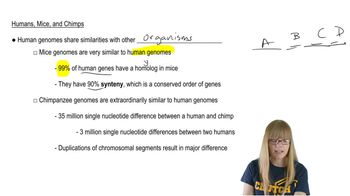Table of contents
- 1. Introduction to Genetics51m
- 2. Mendel's Laws of Inheritance3h 37m
- 3. Extensions to Mendelian Inheritance2h 41m
- 4. Genetic Mapping and Linkage2h 28m
- 5. Genetics of Bacteria and Viruses1h 21m
- 6. Chromosomal Variation1h 48m
- 7. DNA and Chromosome Structure56m
- 8. DNA Replication1h 10m
- 9. Mitosis and Meiosis1h 34m
- 10. Transcription1h 0m
- 11. Translation58m
- 12. Gene Regulation in Prokaryotes1h 19m
- 13. Gene Regulation in Eukaryotes44m
- 14. Genetic Control of Development44m
- 15. Genomes and Genomics1h 50m
- 16. Transposable Elements47m
- 17. Mutation, Repair, and Recombination1h 6m
- 18. Molecular Genetic Tools19m
- 19. Cancer Genetics29m
- 20. Quantitative Genetics1h 26m
- 21. Population Genetics50m
- 22. Evolutionary Genetics29m
15. Genomes and Genomics
Comparative Genomics
Problem 22b
Textbook Question
Homology can be defined as the presence of common structures because of shared ancestry. Homology can involve genes, proteins, or anatomical structures. As a result of 'descent with modification,' many homologous structures have adapted different purposes. Is it likely that homologous proteins from different species have the same or similar functions? Explain.
 Verified step by step guidance
Verified step by step guidance1
Understand the concept of homology: Homology refers to similarities due to shared ancestry. In genetics, homologous proteins are those that have evolved from a common ancestral protein.
Consider the evolutionary process: During evolution, proteins can undergo changes or modifications that allow them to adapt to different functions or environments, a process known as 'descent with modification'.
Analyze the function of homologous proteins: While homologous proteins may have originated from a common ancestor, they can evolve to perform different functions in different species. However, they may also retain similar functions if the evolutionary pressures and environmental conditions are similar.
Evaluate the likelihood of similar functions: If the homologous proteins are under similar selective pressures or are involved in fundamental biological processes, it is likely that they will retain similar functions across different species.
Conclude with an explanation: Homologous proteins from different species may have similar functions if they are involved in essential biological processes or if the selective pressures have not significantly altered their function. However, they can also diverge to perform different roles if the evolutionary context demands it.
Recommended similar problem, with video answer:
 Verified Solution
Verified SolutionThis video solution was recommended by our tutors as helpful for the problem above
Video duration:
2mPlay a video:
Was this helpful?
Key Concepts
Here are the essential concepts you must grasp in order to answer the question correctly.
Homology
Homology refers to the similarity in structure or function between different species due to shared ancestry. This concept can apply to various biological levels, including genes, proteins, and anatomical features. Understanding homology is crucial for studying evolutionary relationships and how traits have been modified over time.
Recommended video:
Guided course

Recombination after Single Strand Breaks
Descent with Modification
Descent with modification is a key principle of evolution, suggesting that species evolve over time through changes in their traits. This process leads to the diversification of species from common ancestors, resulting in homologous structures that may serve different functions in different environments. It highlights how evolutionary pressures shape the adaptations of organisms.
Recommended video:
Guided course

Post Translational Modifications
Protein Function and Evolution
Proteins are essential molecules that perform a variety of functions in living organisms, and their functions can evolve over time. While homologous proteins may share structural similarities due to common ancestry, their functions can diverge significantly due to different evolutionary pressures and environmental contexts. This means that homologous proteins from different species may not necessarily have the same or similar functions.
Recommended video:
Guided course

Evolution
Related Videos
Related Practice





